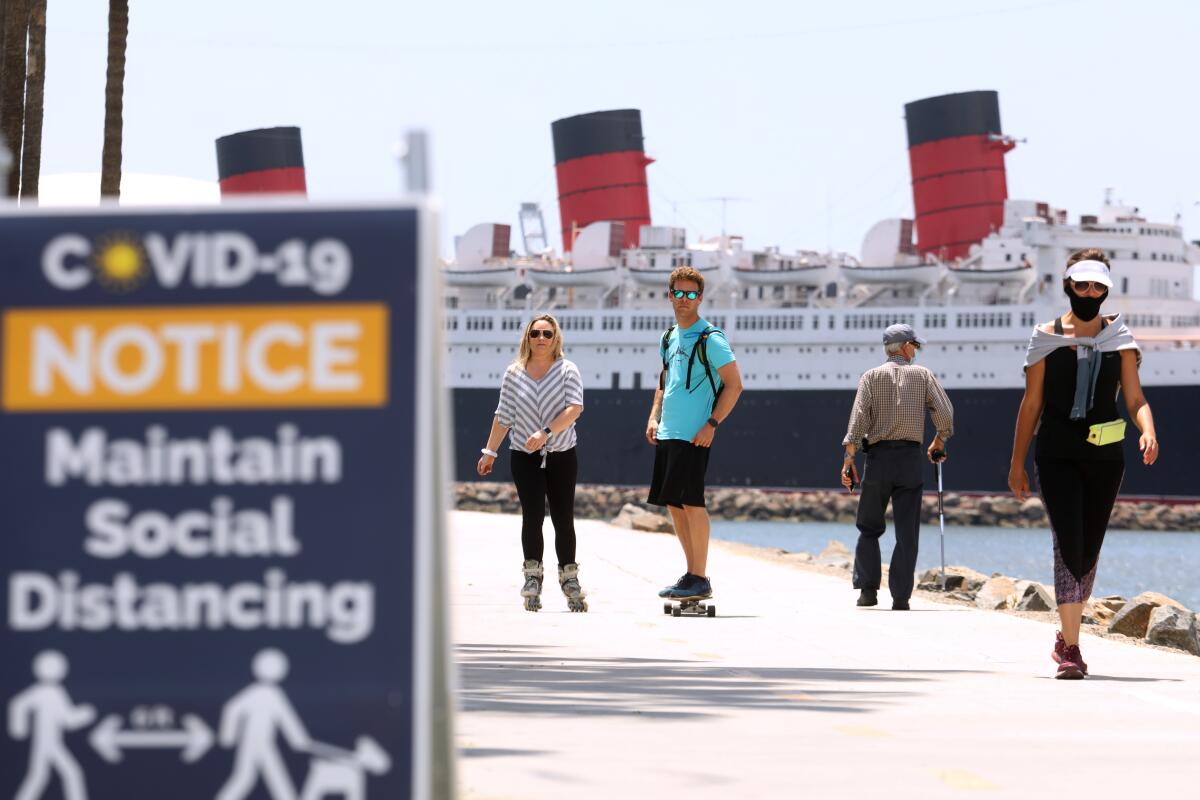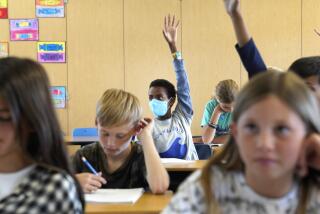As coronavirus deaths mount, California still very much in danger zone

SAN FRANCISCO — Amid a growing clamor to further reopen a California economy devastated by the novel coronavirus, the state is facing one major obstacle that officials say has made swifter progress difficult.
The rate of COVID-19 deaths in California remains at a stubborn plateau. Mirroring a trend seen nationally, California has not seen a dramatic and sustained decline in deaths over the past month, a Los Angeles Times analysis has found. During the seven-day period that ended Sunday, 503 people in California died from the virus — the second-highest weekly death toll in the course of the pandemic and a 1.6% increase from the previous week’s toll.
The average of about 500 fatalities each week has continued over the past month. COVID-19 cases shot up to a weekly record last week, with more than 13,000 new infections reported. Increased testing may partly explain the increase.
Other indicators show that the coronavirus is exhibiting staying power. Hospitalizations have persisted statewide, fueled by the situation in Southern California, the San Joaquin Valley and San Diego County.
The figures have state and local officials warning that it might take some time to significantly relax stay-at-home rules, especially in hot spots like Los Angeles County, which reported 39 more deaths Monday, for a total of 1,570. L.A. County has accounted for more than half of all COVID-19 deaths and nearly half of the cases in California.
Even as Gov. Gavin Newsom has signaled a steady process for reopening the state, he has repeatedly emphasized that the death toll continues to climb.
“I’ll remind people that think the big emergency is over ... [that] we can go back to the way things used to be. ... Tell that to 92 families that were destroyed because they lost a loved one to this virus in the last 24 hours. This, by no stretch of the imagination, is over,” Newsom said last week.
The state’s death toll — which sits at more than 2,770 — is markedly lower than New York’s, with more than 26,000 dead, or New Jersey’s, with more than 9,000.
But experts said there are many Californians who haven’t been infected yet, and that it would be a mistake to assume the state is out of the woods. UC San Francisco epidemiologist and infectious disease expert Dr. George Rutherford, a former epidemic intelligence service officer with the U.S. Centers for Disease Control and Prevention, said California hasn’t overcome its first wave of cases.
“As long as it’s going up, it has not ended,” he said. “It’s got to come down for it to end.”
The first wave of the COVID-19 pandemic appears different so far from the first wave of the 1918 flu pandemic, which lasted only a month in the early summer and, according to Rutherford, faded as U.S. troops headed to Europe to fight in World War I. The second wave, many times more deadly, started in the fall and continued as troops came home.
Today, experts say, a significant part of the population has chosen not to stay home or has been unable to do so because they’re essential workers.
A U.S. Centers for Disease Control and Prevention study estimated that by April 1, about two weeks into a regional stay-at-home order, 47% of residents in five San Francisco Bay Area counties were still leaving their homes, down from 80% in late February.
With California in the eighth week of its stay-at-home order, Newsom on Friday allowed some retail businesses to reopen for curbside service, as long as such activity didn’t violate stricter local health orders. And local governments have allowed many beaches and trails to reopen, while requiring social distancing.
Los Angeles County beaches are expected to reopen with social distancing rules Wednesday, allowing surfing, swimming, running and walking but banning biking, playing volleyball, sitting, sunbathing and picnicking. Parking lots, bike paths, piers and boardwalks will remain closed. Everyone will be required to wear masks and stay at least six feet away from others, officials said.
But local officials in the hardest-hit counties suggested a broader reopening would be slow in L.A. and the Bay Area.
“It’s safer to stay at home,” Barbara Ferrer, the L.A. County director of public health, said Monday. “This is our new normal. It will go on for a while.”
With summer approaching, health officials on Monday urged the public to not take leisure trips, including weekend trips, while the pandemic continues.
“We are, in fact, asking people in our health officer order to avoid nonessential travel, and we would ask that our neighbors across the state and across the country do the same,” Ferrer said. “There’s probably very few places in the world right now that would like to see travel into their communities.”
“It’s best for people to limit their travel to essential travel,” added Dr. Grant Colfax, San Francisco’s director of public health. “This is not the time to go on a trip for recreation or vacation, even to visit family and friends.”
There is no mandatory 14-day quarantine for visitors coming to California, as is the case in Hawaii, where violations are punishable by a $5,000 fine and a year in prison. But Ferrer requested that people coming to L.A. County “do self-quarantine when you come in [and] you do keep yourself away from other people … for that 14-day period.”
On Sunday, an influential coronavirus forecast projected a worsening death toll by early August. The University of Washington’s Institute for Health Metrics and Evaluation now forecasts a California death toll of more than 6,000 by early August, up from the forecast of 4,600 that was issued a week ago.
The state is among eight predicted to see the largest increases in projected cumulative deaths, according to a forecast issued May 4 and updated Sunday. This group also included Pennsylvania, Illinois, Arizona, Florida, Mississippi, Missouri and Connecticut. As a whole, the U.S. is now projected to record more than 137,000 deaths by early August, up from a forecast of 134,000 issued last week. The national death toll on Monday topped 80,600.
Experts expect the number of fatalities to grow nationally.
“We’re headed for potentially a very large outbreak in the fall, which will make whatever we’ve seen pale in comparison,” Rutherford said. It’s possible, he said, that children could further spread the disease when they return to school.
Rutherford says there’s a risk that some states that are opening up too quickly will see a rising death toll — and the effects of the pandemic will disproportionately hit Latinos and blacks.
Rutherford says society does need to reopen — it’s too destructive to continue to be closed — but it needs to be done carefully.
“If we have a prolonged depression, that has tremendous costs in morbidity and mortality as well. So it’s a trade-off: Just understand that we’re trading economy for lives,” Rutherford said.
“Make no mistake … the more the economy opens up, the more people are going to die,” he added. “You have to be really careful to minimize that number and make sure it’s not on the backs of all the poor people who are doing the front-line jobs who are going to get the most exposed.”
Lin reported from San Francisco; Lee and Shalby from Los Angeles. Times staff writers Phil Willon and Laura J. Nelson contributed to this report.
More to Read
Sign up for Essential California
The most important California stories and recommendations in your inbox every morning.
You may occasionally receive promotional content from the Los Angeles Times.













